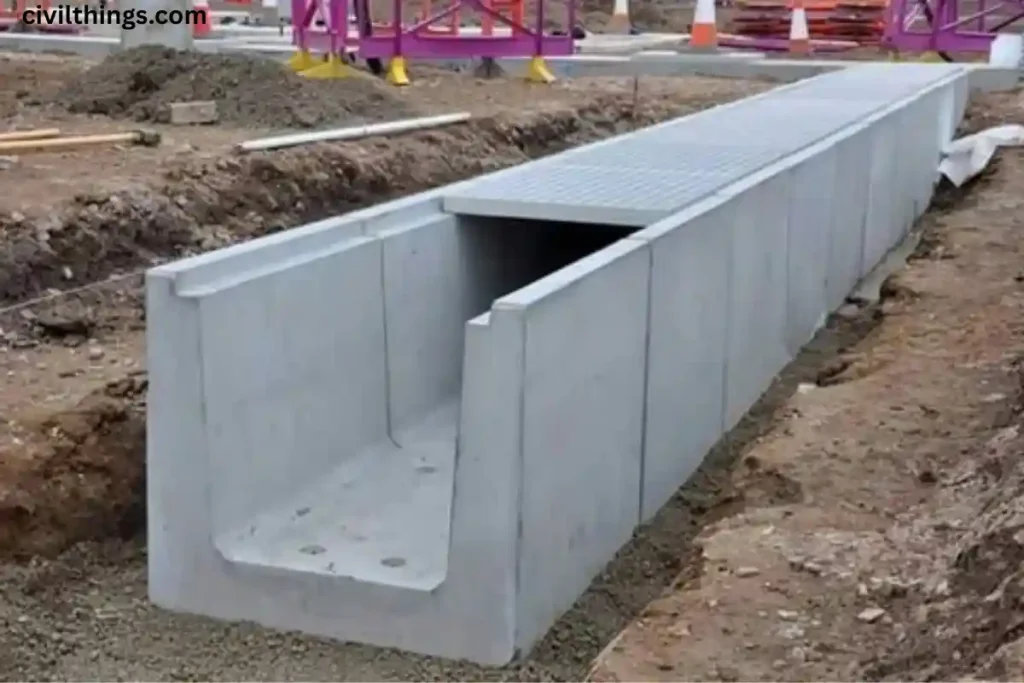Table of Contents
The Ultimate Guide to Precast Drain & U-Drain Systems | RCC Explained. Discover the benefits of precast drain and U-drain systems. Learn about RCC drain strength, installation, types, capacity, and how they prevent flooding. Your complete drainage guide.
The Ultimate Guide to Precast Drain and U-Drain Systems: Efficiency in Modern Drainage
Imagine a heavy downpour. Instead of waterlogging and chaos, you see water smoothly and efficiently channeled away from roads, buildings, and public spaces. This isn’t magic; it’s the result of smart, planned drainage systems. At the heart of this modern infrastructure lies a simple yet powerful solution: the precast drain.
In this complete guide, we will demystify everything you need to know about precast drainage channel systems. We’ll answer your most pressing questions, from “What is a U-drain?” to “Which is stronger, PCC or RCC?” and equip you with the knowledge to make informed decisions for your next project. Whether you’re a homeowner, a civil engineer, or a construction enthusiast, you’ll find this resource invaluable.
What is a Precast Drain? The Foundation of Modern Drainage
Let’s start with the basics. A precast drain is a drainage component that is manufactured in a controlled factory environment rather than being cast in situ (on-site). These units, which include varieties like the U drain and drain box, are then transported to the construction site for assembly.
Think of it like building with LEGO blocks. Instead of mixing concrete and building a drain channel from scratch on location, you use high-quality, pre-made blocks designed to fit together perfectly. This method is at the core of precast drainage channel technology, revolutionizing how we manage water flow.
Why Choose a Precast Drainage System?
The shift towards precast drainage channel solutions is driven by undeniable benefits:
- Superior Quality Control: Factory conditions ensure consistent mix design, vibration, and curing, leading to a higher-quality concrete drain every single time.
- Rapid Installation: Since the components are ready-made, installation is incredibly fast. This significantly reduces project timelines, saving both time and money. You can learn more about efficient project planning and cost-saving in our guide on How to Save Up to $5000 in Construction.
- Unmatched Durability: Precast units are typically made from Reinforced Cement Concrete (RCC), making them incredibly strong and resistant to heavy loads, weather, and chemical corrosion.
- Cost-Effectiveness: While the initial unit cost might be comparable, the savings in labor, time, and on-site supervision make precast drain systems more economical in the long run.
- Standardization: Precast products come in standard sizes, ensuring compatibility and ease of design.
Demystifying the U-Drain: What, Why, and How?
One of the most popular types of precast drain is the U-drain. Its name comes from its distinctive cross-sectional shape, which resembles the letter ‘U’.
What is a U-Drain?
A U drain is a type of precast drainage channel with a U-shaped profile. It is designed to efficiently collect and convey surface water. These systems are often used in conjunction with grating covers and can be connected to a larger drain box or main sewer line.
What is a U-Drain Used For?
The versatility of the U drain makes it a go-to solution for numerous applications:
- Roadside Drainage: Channeling water from roads and highways.
- Parking Lots: Preventing water accumulation in commercial and residential parking areas.
- Airports and Ports: Managing large volumes of surface water in critical infrastructure.
- Industrial Facilities: Handling runoff that may contain mild chemicals, for which a durable concrete drain is ideal.
- Pedestrian Walkways and Plazas: Ensuring safe, dry surfaces for public use.
How Do U Drains Prevent Flooding?
The mechanism is straightforward but highly effective. A U drain acts as a first line of defense against surface water. By providing a dedicated, smooth pathway, it quickly captures runoff before it can pool. This efficient conveyance reduces the burden on main sewer systems during peak rainfall, directly mitigating urban flooding risks. A well-designed network of U drain components is essential for any flood-resilient community.
Diving Deeper: The Technicalities of Drains

To truly understand the value of a precast drain, we need to look at the technical details.
What is the Full Form of RCC Drain?
RCC stands for Reinforced Cement Concrete. Therefore, an RCC drain is a drain made from concrete that is strengthened with steel reinforcement bars (rebar). This reinforcement gives the concrete drain its high tensile strength, allowing it to withstand heavy loads and pressures without cracking.
For accurate planning of the steel reinforcement in such projects, a Bar Bending Schedule (BBS) is crucial. You can learn how to create one with our step-by-step guide: Bar Bending Schedule (BBS): Step-by-Step Guide + Download BBS Excel Sheet Free.
Which is Stronger: PCC or RCC?
This is a fundamental question in construction.
- PCC (Plain Cement Concrete): Has good compressive strength but is weak in handling tension (bending or stretching forces).
- RCC (Reinforced Cement Concrete): The embedded steel rebars take on the tensile stresses, while the concrete handles the compression. This synergy makes RCC vastly stronger and more durable than PCC.
Verdict: For any drainage system that needs to endure vehicle loads, soil pressure, or thermal expansion, an RCC drain is unequivocally the stronger and recommended choice. A precast drain is almost always an RCC drain.
What is the Minimum Thickness of an RCC Drain?
The thickness of an RCC drain is not a random number; it’s calculated based on the expected load, the depth of the drain, and the soil conditions. However, for standard precast U drain sections used in light to medium-duty applications (like residential driveways or walkways), wall thickness typically ranges from 75 mm to 150 mm. For heavy-duty applications like airports or highways, the thickness can be 200 mm or more. Always consult structural design specifications for your specific project.
What is the Capacity of a U-Drain?
The capacity of a U drain refers to the volume of water it can carry per unit of time. It depends on three key factors:
- Cross-Sectional Area: The size of the ‘U’ (width and depth).
- Slope (Gradient): The steeper the slope, the faster the water flows, increasing capacity.
- Surface Roughness: The smoothness of the precast concrete interior affects flow velocity.
Measuring Drain Size: How is it Done?
- Internal Width: The distance between the two inner walls of the drain.
- Internal Height: The vertical distance from the channel base to the top of the opening.
- Overall Length: The length of each precast section.
For complex capacity calculations and project estimations, using a tool like our Row House Construction Estimation Excel Sheet can be extremely helpful to manage all your material and cost data.
Exploring the Variety: Types and Patterns of Drainage
What are the Different Types of U Drains?
While the basic U-shape is constant, variations exist to suit different needs:
- Standard U-Drain: The most common type, used for general surface water drainage.
- Slot Drain: A sleek, linear U drain with a narrow slot opening, popular in modern architectural designs for pedestrian areas.
- Trench Drain: A broader term often synonymous with U-drains, but can refer to larger systems that handle higher flow rates.
- Chemical Resistant U-Drain: Made with special aggregates or coatings to withstand corrosive substances in industrial settings.
What are the 4 Drainage Patterns?
In geomorphology and civil engineering, drainage patterns refer to the layout formed by streams and rivers in a basin. Understanding these helps in planning large-scale precast drainage channel networks:
- Dendritic: Resembles a tree’s branches. It is the most common pattern and develops in regions with uniform soil and rock type.
- Trellis: Looks like a garden trellis, with tributaries meeting the main river at right angles. Common in folded mountain regions.
- Rectangular: Characterized by right-angle bends in the streams, controlled by jointed or faulted bedrock.
- Radial: Streams flow outward from a central high point, like a volcano.
What are “Three Drains”?
The term “three drains” is not a standard technical term. It could be a misinterpretation or a colloquial phrase. In professional contexts, we refer to:
- Primary Drains: Main trunk lines.
- Secondary Drains: Branch lines that feed into the primary drain.
- Tertiary Drains: Smaller, localized drains (like a U drain or drain box) that collect water directly from the surface and feed into the secondary system.
So, “three drains” likely refers to this hierarchical system of primary, secondary, and tertiary drainage.
The Practical Side: Installation and Project Integration
Are U Drains Easy to Install?
Yes, one of the biggest advantages of a precast U drain is its ease of installation. The process is straightforward:
- Excavation: A trench is dug to the required depth and slope.
- Bedding: A layer of compacted granular material (like gravel) is laid to create a stable, level base.
- Placement: The precast sections are lowered into the trench and aligned.
- Connection: Sections are butted together, and seals are applied to joints to prevent leakage.
- Backfilling: The area around the drain is carefully backfilled and compacted in layers.
Compared to building a drain on-site, this process is significantly faster and requires less skilled labor.
Who Uses Precast Drainage Systems?
The user base for precast drainage channel products is vast:
- Civil Engineers & Contractors: For public infrastructure projects like roads, bridges, and city planning.
- Architects & Landscape Designers: For integrating seamless drainage into commercial complexes, parks, and residential projects.
- Industrial Plant Managers: For managing wastewater and runoff in factories.
- Government Municipalities: For maintaining and upgrading public drainage systems.
Using advanced design software is common for these professionals. For instance, you can explore Revit Software for Civil Engineering Download to see how drainage systems are modeled in BIM environments.
Conclusion: Building a Drier, Smarter Future with Precast Drains
The humble precast drain, especially the versatile U drain, is an unsung hero of modern construction. Its strength, derived from the RCC drain design, combined with the efficiency of factory production, offers a superior solution for managing surface water. From preventing urban flooding to ensuring the longevity of our infrastructure, the benefits are clear.
By choosing a high-quality precast drainage channel system, you are investing in durability, cost savings, and a more resilient built environment. Whether your project is a simple driveway or a complex industrial facility, understanding and utilizing these systems is key to its success.
For further refinement of your construction designs, including interior elements, feel free to browse our collection of resources, such as Best Almari Designs for Bedroom DWG File Download.
Frequently Asked Questions (FAQs)
Q1: What is the full form of RCC drain?
A: RCC stands for Reinforced Cement Concrete. An RCC drain is a concrete drain fortified with steel bars for enhanced strength and durability.
Q2: What is a U-drain used for?
A: A U drain is used for efficiently collecting and channeling surface water in areas like roads, parking lots, walkways, and industrial sites to prevent waterlogging and flooding.
Q3: Which is stronger, PCC or RCC?
A: RCC (Reinforced Cement Concrete) is significantly stronger than PCC (Plain Cement Concrete) because the steel reinforcement in RCC provides high tensile strength, which PCC lacks.
Q4: Are U drains easy to install?
A: Yes, U drains are designed for easy installation. Being precast, they are simply placed in a pre-dug trench on a prepared bed, connected, and then backfilled, saving considerable time and labor.
Q5: What is the capacity of a U-drain?
A: The capacity of a U drain depends on its internal dimensions (width and depth) and the slope at which it is installed. Larger dimensions and steeper slopes allow for a greater water flow capacity.
Q6: How do I measure drain size?
A: Drain size is typically measured by its internal width and internal height (the open space through which water flows), as well as the overall length of the precast drain section.
External Resources for Further Reading:
- National Precast Concrete Association (NPCA) – Drainage Products
- The Constructor – Civil Engineering Home
Internal Links Used:
- How to Save Up to $5000 in Construction
- Bar Bending Schedule (BBS): Step-by-Step Guide + Download BBS Excel Sheet Free
- Row House Construction Estimation Excel Sheet
- Revit Software for Civil Engineering Download
- Best Almari Designs for Bedroom DWG File Download

Hi! I’m Sandip, a civil engineer who loves sharing about Civil Engineering & new ideas and tips. My blog helps you learn about engineering in a fun and easy way!

